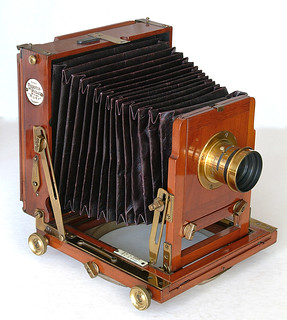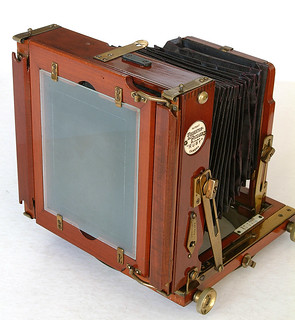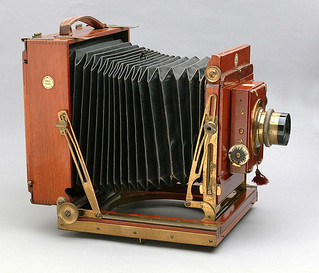Difference between revisions of "Thornton-Pickard Ruby"
m (Added link) |
Hanskerensky (talk | contribs) (Added Category:UK) |
||
| (11 intermediate revisions by 2 users not shown) | |||
| Line 1: | Line 1: | ||
| − | + | The '''Ruby''' is a wooden folding field camera made by [[Thornton-Pickard]] from about 1890 to 1907.<ref name=W&BRuby>[http://www.woodandbrass.co.uk/detail.php?cat_num=0031 Half-plate Ruby] of about 1897, at [http://www.woodandbrass.co.uk/index.php Wood and Brass].</ref> Intended for use on a tripod, the folding bed includes a turntable. The design was changed to make the camera also usable as a hand camera.<ref name=Pat>[https://worldwide.espacenet.com/patent/search?q=pn%3DGB189522136A British Patent 22136] of 1895, ''Improvements in Photographic Cameras'', granted to John Thornton and Edgar Pickard, and describing changes to a stand camera 'such as is well known as the Thornton Pickard Ruby Camera' to make it suitable for hand-held use as well as on a stand; at [http://worldwide.espacenet.com/ Espacenet], the patent search facility of the European Patent Office.</ref> | |
| − | The '''Ruby''' is a wooden folding field camera made by [[Thornton-Pickard]] from about 1890 to 1907.<ref name=W&BRuby>[http://www.woodandbrass.co.uk/detail.php?cat_num=0031 Half-plate Ruby] of about 1897, at [http://www.woodandbrass.co.uk/index.php Wood and Brass].</ref> Intended for use on a tripod, the folding bed includes a turntable. The design was changed to make the camera also usable as a hand camera.<ref name=Pat>[ | ||
McKeown states that the camera has a 'Ruby' Rapid-Rectilinear lens.<ref name=McK>{{McKeown12}} p918.</ref> This is mounted on a Thornton-Pickard roller-blind shutter on the front standard. | McKeown states that the camera has a 'Ruby' Rapid-Rectilinear lens.<ref name=McK>{{McKeown12}} p918.</ref> This is mounted on a Thornton-Pickard roller-blind shutter on the front standard. | ||
| − | The '''Royal Ruby''' is a very similar camera, introduced as a high-specification version of the Ruby in about 1900,<ref name=W&BRoyal>[http://www.woodandbrass.co.uk/detail.php?cat_num=0087 Royal Ruby in half-plate] and [http://www.woodandbrass.co.uk/detail.php?cat_num=0072 full plate] sizes, dated by the site owner to about 1900 and 1907 respectively, at ''Wood and Brass''.</ref> and continued in production for some years after the standard Ruby was discontinued. McKeown states that all Royal Ruby cameras are triple extension (allowing close focus, or long-focus lenses).<ref name=McK/> Examples exist with roller-blind shutters on the lens board,<ref name=West_Royal1>[ | + | The '''Royal Ruby''' is a very similar camera, introduced as a high-specification version of the Ruby (Notes at ''Early Photography'' describe it as the top of T-P's range<ref name=EP>[http://earlyphotography.co.uk/site/entry_C356.html Royal Ruby] at [http://earlyphotography.co.uk Early Photography]: details and pictures of a quarter-plate camera and a half-plate one with nickel-plated fittings.</ref>) in about 1900,<ref name=W&BRoyal>[http://www.woodandbrass.co.uk/detail.php?cat_num=0087 Royal Ruby in half-plate] and [http://www.woodandbrass.co.uk/detail.php?cat_num=0072 full plate] sizes, dated by the site owner to about 1900 and 1907 respectively, at ''Wood and Brass''.</ref> and continued in production for some years after the standard Ruby was discontinued. McKeown states that all Royal Ruby cameras are triple extension (allowing close focus, or long-focus lenses).<ref name=McK/> Examples exist with roller-blind shutters on the lens board,<ref name=West_Royal1>[https://www.leitz-auction.com/en/Thornton-Pickard-Royal-Ruby-outfit/AI-15-18455 Half-plate Royal Ruby outfit], dated by the auctioneer to about 1925; camera, T-P wooden tripod, two lenses and several front shutters, sold at the [https://www.leitz-auction.com/en/Cameras/Past-Auctions/Auction-15/ fifteenth Westlicht Photographica Auction], on 23 May 2009.</ref> and with a built-in ''focal-plane'' shutter.<ref name=West_Royal2>[https://www.leitz-auction.com/en/Thornton-Pickard-Royal-Ruby/AI-10-15308 Half-plate Royal Ruby], dated by the auctioneer to about 1904, with built-in T-P 'Unit' focal-plane shutter, offered for sale at the [https://www.leitz-auction.com/en/Cameras/Past-Auctions/Auction-10/ tenth Westlicht auction], on 18 November 2006.</ref> Royal Ruby cameras have been seen in quarter- half- and full-plate, and 4x5-inch and (perhaps) 5x7½-inch (or 13x18cm) sizes. Notes at ''Early Photography'' state that 5x7½-inch and 8x10-inch cameras were introduced in 1907, when the quarter-plate and 4x5-inch sizes were discontinued.<ref name=EP/><ref name=W&BRoyal/><ref>[https://www.leitz-auction.com/en/Thornton-Pickard-Royal-Ruby/AI-36-38304 Royal Ruby] camera described as 13x18cm (and with 13x18 reducing masks for the plate/film holders) but perhaps actually the similar 5x7½-inch size, sold at the [https://www.leitz-auction.com/en/Cameras/Past-Auctions/Auction-36/ 36th Leitz Photographica Auction] in June 2020.</ref> There is also a [[Thornton-Pickard Royal Ruby stereo camera|half-plate stereo model]]. |
| − | The '''Special Ruby''', strangely, was introduced as a ''lower''-specification version of the Ruby, also shortly before the standard model was discontinued.<ref name=McK/> ''Wood and Brass'' shows an example from 1909-12, with a spring back (for easy insertion of dark slides in front of the focusing screen) and with triple extension;<ref name=W&BSpecial>[http://www.woodandbrass.co.uk/detail.php?cat_num=0037 Half-plate Special Ruby], about 1909-12, at ''Wood and Brass''; this example has triple extension and a spring back. Its shutter is missing from the lens board.</ref> the notes state that these features were among those left off the Special at first, and that they were reintroduced in about 1908, so the camera is very similar to a standard Ruby. McKeown lists the | + | The '''Special Ruby''', strangely, was introduced as a ''lower''-specification version of the Ruby, also shortly before the standard model was discontinued.<ref name=McK/> ''Wood and Brass'' shows an example from 1909-12, with a spring back (for easy insertion of dark slides in front of the focusing screen) and with triple extension;<ref name=W&BSpecial>[http://www.woodandbrass.co.uk/detail.php?cat_num=0037 Half-plate Special Ruby], about 1909-12, at ''Wood and Brass''; this example has triple extension and a spring back. Its shutter is missing from the lens board.</ref> the notes state that these features were among those left off the Special at first, and that they were reintroduced in about 1908, so the camera is very similar to a standard Ruby. McKeown lists the Special Ruby as ''double'' extension.<ref name=McK/> |
| Line 35: | Line 34: | ||
|image_rights= wp | |image_rights= wp | ||
}} | }} | ||
| − | |||
| − | |||
| − | |||
==Notes== | ==Notes== | ||
<references/> | <references/> | ||
| − | |||
[[Category: 1890-1899]] | [[Category: 1890-1899]] | ||
| − | [[Category: Thornton-Pickard]] | + | [[Category: Thornton-Pickard|Ruby]] |
[[Category: Folding plate]] | [[Category: Folding plate]] | ||
| + | [[Category:R|Ruby Thornton-Pickard]] | ||
| + | [[Category:View cameras]] | ||
| + | [[Category:UK]] | ||
Latest revision as of 04:48, 8 March 2024
The Ruby is a wooden folding field camera made by Thornton-Pickard from about 1890 to 1907.[1] Intended for use on a tripod, the folding bed includes a turntable. The design was changed to make the camera also usable as a hand camera.[2]
McKeown states that the camera has a 'Ruby' Rapid-Rectilinear lens.[3] This is mounted on a Thornton-Pickard roller-blind shutter on the front standard.
The Royal Ruby is a very similar camera, introduced as a high-specification version of the Ruby (Notes at Early Photography describe it as the top of T-P's range[4]) in about 1900,[5] and continued in production for some years after the standard Ruby was discontinued. McKeown states that all Royal Ruby cameras are triple extension (allowing close focus, or long-focus lenses).[3] Examples exist with roller-blind shutters on the lens board,[6] and with a built-in focal-plane shutter.[7] Royal Ruby cameras have been seen in quarter- half- and full-plate, and 4x5-inch and (perhaps) 5x7½-inch (or 13x18cm) sizes. Notes at Early Photography state that 5x7½-inch and 8x10-inch cameras were introduced in 1907, when the quarter-plate and 4x5-inch sizes were discontinued.[4][5][8] There is also a half-plate stereo model.
The Special Ruby, strangely, was introduced as a lower-specification version of the Ruby, also shortly before the standard model was discontinued.[3] Wood and Brass shows an example from 1909-12, with a spring back (for easy insertion of dark slides in front of the focusing screen) and with triple extension;[9] the notes state that these features were among those left off the Special at first, and that they were reintroduced in about 1908, so the camera is very similar to a standard Ruby. McKeown lists the Special Ruby as double extension.[3]

|
| Ruby 4×5 inch image by Geoff Harrisson (Image rights) |

|
| showing the later style back image by Geoff Harrisson (Image rights) |

|
| Special Ruby 1/2 plate image by Geoff Harrisson (Image rights) |
Notes
- ↑ Half-plate Ruby of about 1897, at Wood and Brass.
- ↑ British Patent 22136 of 1895, Improvements in Photographic Cameras, granted to John Thornton and Edgar Pickard, and describing changes to a stand camera 'such as is well known as the Thornton Pickard Ruby Camera' to make it suitable for hand-held use as well as on a stand; at Espacenet, the patent search facility of the European Patent Office.
- ↑ 3.0 3.1 3.2 3.3 McKeown, James M. and Joan C. McKeown's Price Guide to Antique and Classic Cameras, 12th Edition, 2005-2006. USA, Centennial Photo Service, 2004. ISBN 0-931838-40-1 (hardcover). ISBN 0-931838-41-X (softcover). p918.
- ↑ 4.0 4.1 Royal Ruby at Early Photography: details and pictures of a quarter-plate camera and a half-plate one with nickel-plated fittings.
- ↑ 5.0 5.1 Royal Ruby in half-plate and full plate sizes, dated by the site owner to about 1900 and 1907 respectively, at Wood and Brass.
- ↑ Half-plate Royal Ruby outfit, dated by the auctioneer to about 1925; camera, T-P wooden tripod, two lenses and several front shutters, sold at the fifteenth Westlicht Photographica Auction, on 23 May 2009.
- ↑ Half-plate Royal Ruby, dated by the auctioneer to about 1904, with built-in T-P 'Unit' focal-plane shutter, offered for sale at the tenth Westlicht auction, on 18 November 2006.
- ↑ Royal Ruby camera described as 13x18cm (and with 13x18 reducing masks for the plate/film holders) but perhaps actually the similar 5x7½-inch size, sold at the 36th Leitz Photographica Auction in June 2020.
- ↑ Half-plate Special Ruby, about 1909-12, at Wood and Brass; this example has triple extension and a spring back. Its shutter is missing from the lens board.